Abstract
Among root vegetables in Japanese agriculture, lotus root is one of the important crops. According to data for 2022, the lotus root harvest volume per prefecture was up to 56.2kt. Moreover, the maximum cultivated area is 4.02 kha, which suggests that it is cultivated over a wide area. In terms of shipping volume, Ibaraki recorded the highest volume at 24.5kt. Considering past trends, it appears that lotus root cultivation is thriving throughout Japan, with many farmers engaged in production, especially at the prefectural level. While Ibaraki holds the lead in terms of shipping volume, it appears that other regions also have a certain level of production. This indicates that areas with suitable climatic conditions and soil are suitable for lotus root production. In addition, the lotus root market in Japan is stable, with demand and supply being relatively harmonious. As nutritional value and cooking variety of lotus root becomes more widespread among consumers, the demand for lotus root is likely to remain at a constant level. In the future, technological innovations and changes in agricultural policies are expected to further increase production and reduce regional differences.
Lotus root harvest yield (main data).
Japanese agriculture’s lotus root harvest peaked at 104kt in 1973, but has been on a downward trend since then. As of 2022, the national harvest volume remains at 53.8%, about half of its peak. The reasons for this decline include a reduction in farmland, the mechanization of agriculture, and urbanization. On the other hand, each region has its own unique characteristics. While lotus root production is booming in some regions and yields have remained relatively stable, other regions are seeing a decline in production. This may be due to factors such as climate, soil conditions and farm management strategies. Furthermore, in recent years, interest in root vegetables has grown along with growing health consciousness and diversifying food culture. Following this trend, lotus root production may increase again in some areas. However, future prospects are unclear as various factors, such as changes in agricultural policies and market demand, will affect harvest yields.
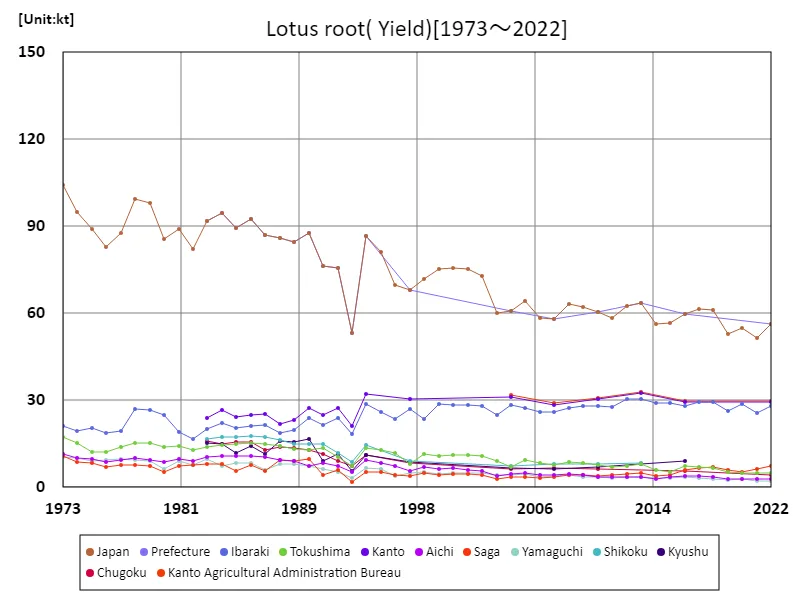

The maximum is 104kt[1973] of Japan, and the current value is about 53.8%
Lotus root harvest volume (by prefecture).
According to 2022 data on root vegetable harvests in Japanese agriculture, Ibaraki recorded the highest yield overall at 28.2kt, making it the current leader in harvest volume. This trend indicates that Ibaraki is a leading region for root vegetable production. Ibaraki’s advantages are a combination of the region’s unique climatic conditions, soil utilization, and advanced agricultural techniques. Root vegetables are also produced actively in other prefectures, and many regions produce them to meet the national demand. Cool regions such as Hokkaido and Aomori in particular have climatic conditions that are ideal for growing root vegetables. On the other hand, there are differences in root vegetable yields in each region. Production volumes vary depending on the region’s climate, soil conditions, and level of agricultural development. Effective agricultural policies and technological innovations take these differences into account. Finally, it is noteworthy that demand for root vegetables is increasing due to consumers becoming more health conscious and raising awareness of local production and consumption. This will ensure that root crop production will continue to play an important role in the future, contributing to improving the local economy and food self-sufficiency.
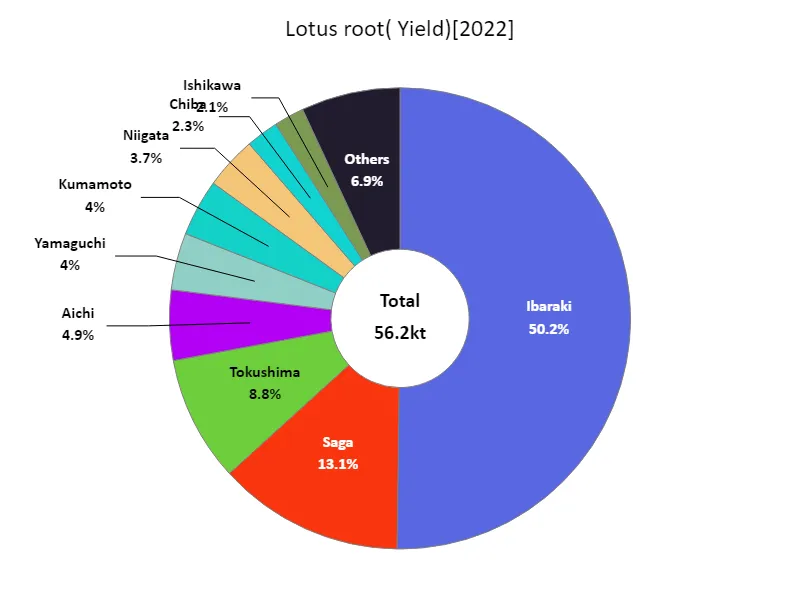

The maximum is 28.2kt of Ibaraki, the average is 1.81kt, and the total is 56.2kt
Area cultivated with lotus root (main data).
The area of lotus root cultivation in Japanese agriculture fluctuates between 1973 and 2022. In 1983, the area cultivated with lotus root in prefectures and prefectures peaked at 6.42 kha, but the current value is only 62.6% of the peak. Possible factors behind this trend include changes in agricultural structure and market demand. One of the reasons why the cultivated area of prefectures has decreased from its peak is the decrease in farmland and the progress of urbanization. Also, the recent increase in conversion to other crops and diversified use of agriculture may be a factor. On the other hand, lotus root production still occupies an important position, as the cultivated area in prefectures and prefectures remains at a constant level. Since climate and soil conditions vary from region to region, it is possible that lotus root is cultivated in areas other than prefectures. In the future, advances in agricultural technology and changes in demand may lead to an increase in the area planted to lotus root again. However, from the perspective of sustainable agriculture, improvements in land use and production methods will be required.
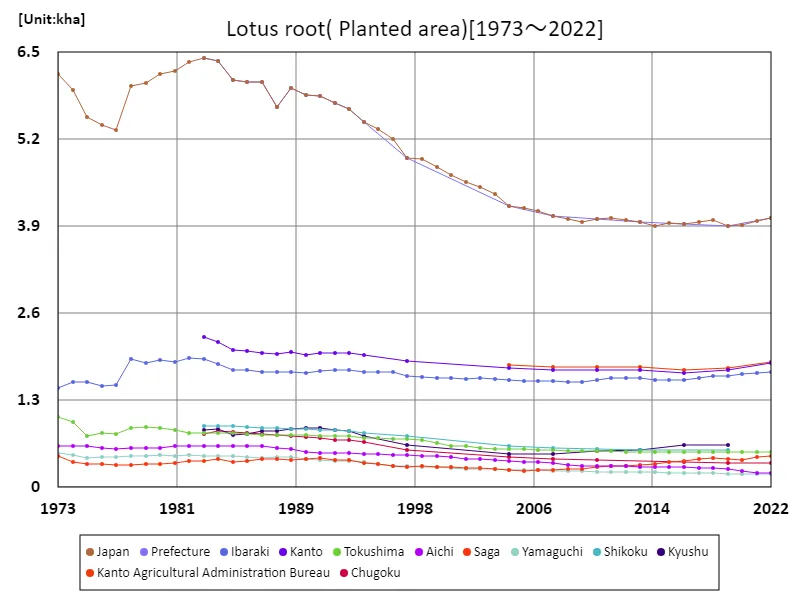

The maximum is 6.42kha[1983] of Japan, and the current value is about 62.6%
Lotus root cultivation area (by prefecture).
According to data from 2022, Ibaraki has the largest area planted to root vegetables in Japanese agriculture, at 1.73kha. This indicates that Ibaraki is a major region for root vegetable production. Ibaraki’s advantages are a combination of the region’s unique climatic conditions, soil utilization, and advanced agricultural techniques. Root vegetables are also grown in other prefectures, with many areas producing more to meet demand. Different regions have different climates and soil conditions, so some areas are particularly suited to growing root vegetables. This has resulted in the dispersion of root crop cultivation across the country. In some areas, the cultivation of root vegetables is being promoted with the aim of promoting the multifaceted use of agriculture and revitalizing the local area. It is also possible that demand for root vegetables is increasing due to consumers becoming more health conscious and raising awareness of local production and consumption. These factors are contributing to an increase in the area planted with root crops. Finally, the implementation of agricultural policies that take into account agricultural sustainability and revitalization of local economies will play an important role in the future cultivation of root crops.
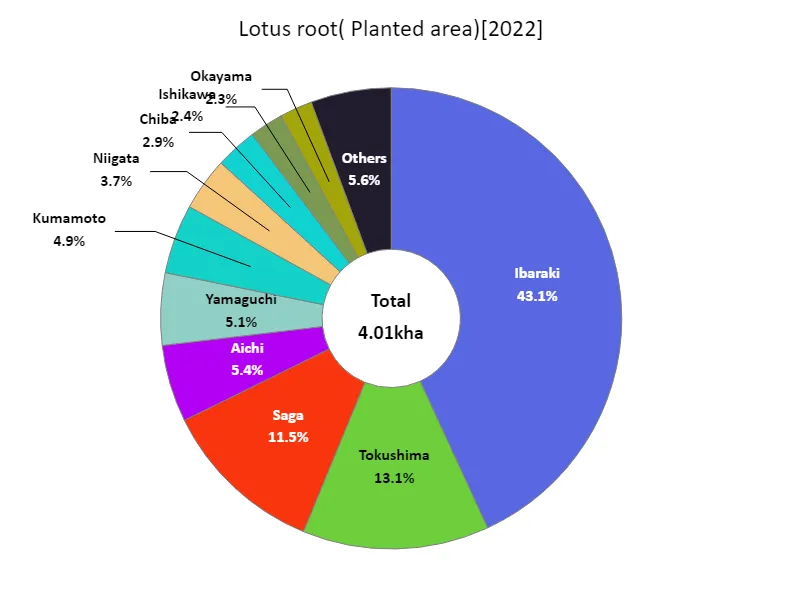

The maximum is 1.73kha of Ibaraki, the average is 129ha, and the total is 4.01kha
Lotus root shipping volume.
According to data from 2022, Ibaraki has the highest lotus root shipment volume in Japanese agriculture, at 24.5kt. The overall average shipment was 1.52kt, with a total shipment of 47.2kt. Ibaraki recorded the largest shipping volume, indicating that this region is a major producer of lotus root. Ibaraki’s advantages come from a combination of the region’s unique climatic conditions, soil utilization, and advances in agricultural technology. In addition, a certain amount of shipping volume is secured in other regions as well, and lotus root is cultivated throughout the country. The average shipping volume was 1.52kt, indicating that the demand and supply of lotus root is relatively stable. This may be due to the continuing popularity of lotus root among consumers and adequate production to meet local demand. Additionally, the total shipping volume of 47.2kt indicates that lotus root is one of the important crops in Japanese agriculture. It is believed that this contributes to the local economy and improves food self-sufficiency. In the future, demand for lotus root is likely to increase as consumers become more health conscious and food culture changes. In order to meet these changes in demand, improvements in production technologies and the implementation of effective agricultural policies will be required.
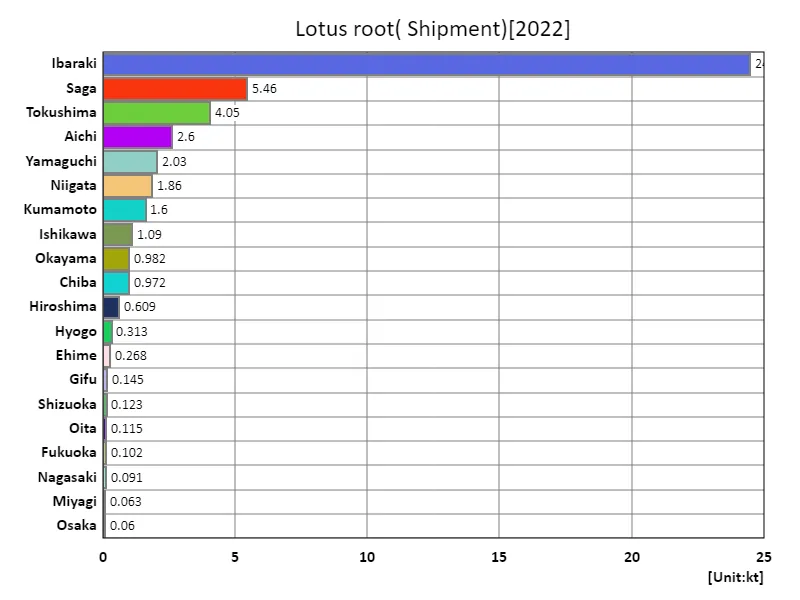

The maximum is 24.5kt of Ibaraki, the average is 1.52kt, and the total is 47.2kt
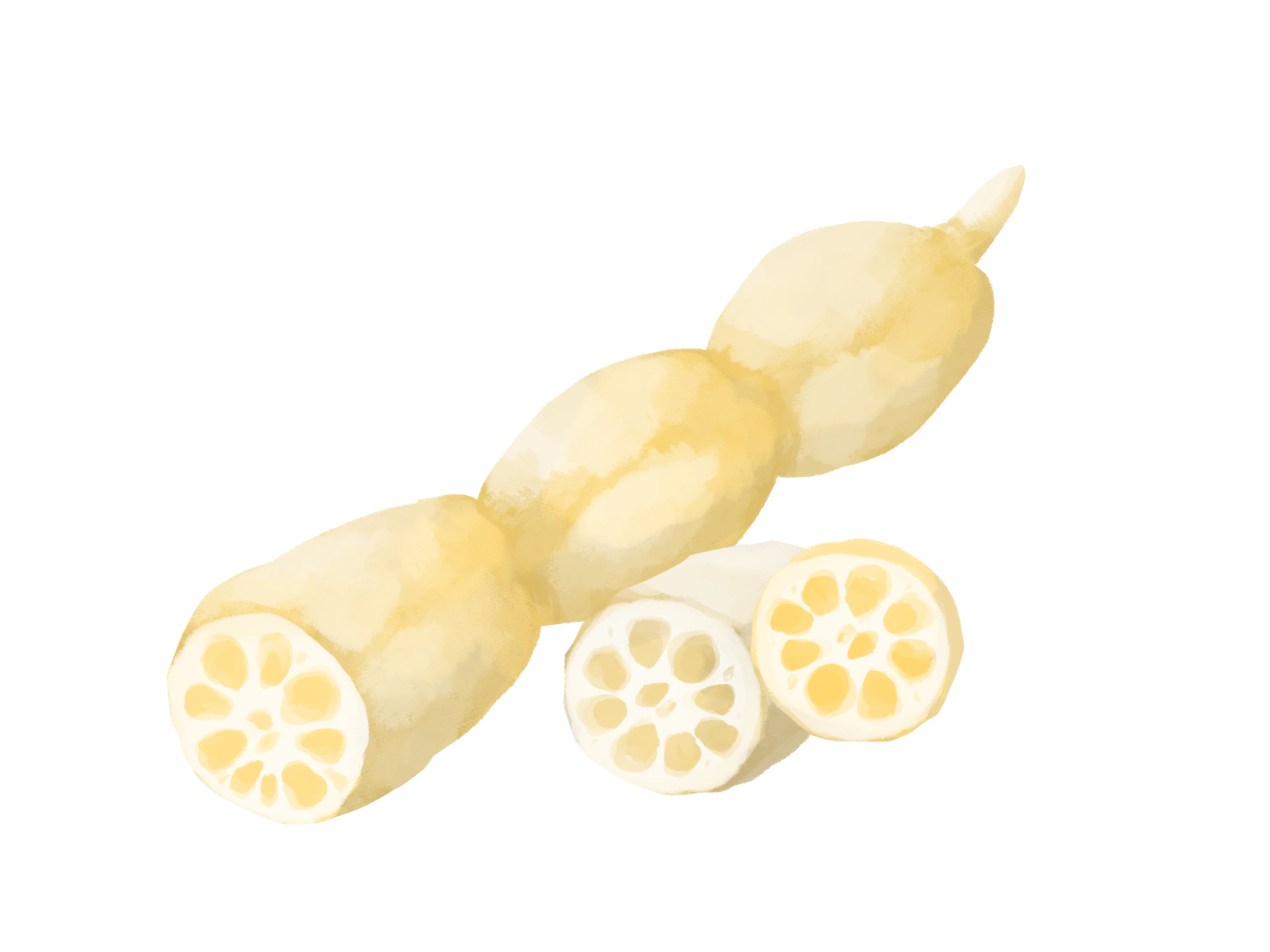


Comments